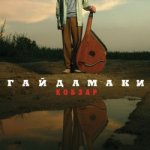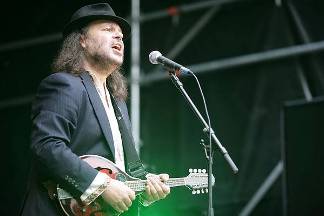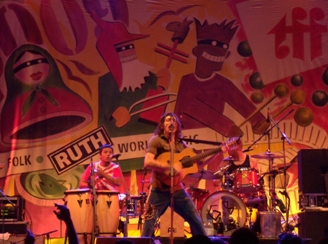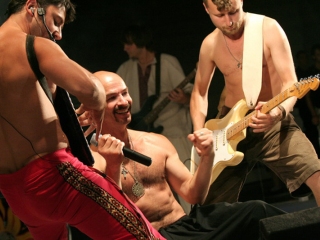FolkWorld #48 07/2012
© Wikipedia, the free encyclopedia
Music of Ukraine
Between 8 June and 1 July 2012, Ukraine alongside with the
Poland[48]
will host the
UEFA European Football Championship.
Plans to go over? Care to see some roots music?
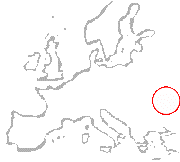 Ukraine (Україна)
Capital:
Ukraine (Україна)
Capital: Kiev
Population: 45,9 mio.
Location:
Ukraine is a country in Central and Eastern Europe. Ukraine borders the Russian Federation to the east and northeast, Belarus to the northwest, Poland, Slovakia and Hungary to the west, Romania and Moldova to the southwest, and the Black Sea and Sea of Azov to the south and southeast, respectively. It has an area of 603,628 km², making it the second largest contiguous country on the European continent, after the Russian Federation.
Ukraine is a multi-ethnic Eastern European state situated north of the Black Sea, previously part of the Soviet Union. Many of its ethnic groups living within Ukraine have their own unique musical traditions and some have developed specific musical traditions in association with the land in which they live.
Traditional ethnic Ukrainian music
Ukraine found itself at the crossroads of Asia and Europe and this is reflected within the music in a perplexing mix of exotic melismatic singing with chordal harmony which does not always easily fit the rules of traditional Western European harmony. The most striking general characteristic of authentic ethnic Ukrainian folk music is the wide use of minor modes or keys which incorporate augmented 2nd intervals. This is an indication that the major-minor system developed in Western European music did not become as entrenched or as sophisticated in Ukraine.
Rhythmically the music rarely uses complex time-signatures, but compound meters are encountered, and the music can be extremely complex harmonically.
Harmonically three and even four part harmony had developed and was recorded in the central steppe regions of Ukraine, but was not in popular use in the mountain regions by the late 19th century.
- Ritual songs show the greatest tendency to preservation. They are frequently in recitative style, essentially monodic, based on notes in the range of a third or a fourth. An example of this style is the theme for the Shchedrivka "Shchedryk" known in the West as "Carol of the Bells".
- A large group of Ukrainian ritual melodies fall within a perfect fourth with the main central tone as the lowest note. Many of the ritual Easter melodies known as Hayivky fall into this category. The tetrachordal system is also found in wedding and harvest songs. Folk dances often have melodies based on two tetrachords fused together.
- The bulk of Ukrainian folk songs melodies are based on scales identical to mеdieval modes, but differ in melodic structure. The Mixolydian and Dorian modes are used more often than Ionian and Aeolian modes. This is a feature of traditional paraliturgical Koliadky.
- The augmented 2nd interval is found, as well as the raising of the fourth and seventh degree of the scale. It is often used for melodic expression. This melodic manner gives an effect that is described as adding severe tension or sadness in some Ukrainian songs. The phenomenon is not found in Russian folk songs and is thought to have been introduced or developed in the 17th century.
Traditional ethnic Ukrainian vocal music and performers
Ukrainian folk song singing style can be divided into a number of broad aesthetic categories.
1. Solo singing - primarily ritual songs including holosinnya sung at wakes.
2. Solo singing with instrumental accompaniment by professional itinerant singers known as kobzari or lirnyky. The highest form of development of this style of singing can be seen in the lyric historical folk epics known as dumy sung to the accompaniment of the bandura, kobza or lira (lirnyk). Dumy were sung primarily in the dorian mode
3. The third is an archaic type of modal "a cappella" vocal style in which a phrase sung by a soloist is answered by a choral phrase in 2- or 3- voice vertical polyphony/heterophony/harmony. The vocal inflection here is quite mediaeval in character, and some peculiarities of distinctly Ukrainian flavor are noticeable, such as parallel fifths and octaves, and several types of plagal cadences. This type of song, once dominant, after 1650 has ceded its hegemony to the newer tonal types, but can still be found in isolated villages. This style is evident in the Kolyadka and Shchedryk.
4. *The other vocal styles are marked by the influences exerted by European music, by paraliturgical music of Danylo Tuptalo and his circle in the early 18th century, and later by classical music and urban culture.
Ukrainian vocal musics exhibit a wide variety of forms – monodic, heterophonic, homophonic, harmonic and polyphonic.
One of the most active proponents of these styles of Ukrainian vocal music is Nina Matviyenko. In recent time groups have been established dedicated to preservation to Ukrainian traditional polyphony, notably "Bozhychi", "Hurtopravci", "Volodar", "Korali" and "Drevo".
Traditional ethnic Ukrainian instrumental folk music and performers
Common traditional instruments include: the kobza (lute), bandura, torban (bass lute), violin, basolya (3-string cello), the relya or lira (hurdy-gurdy) and the tsymbaly; the sopilka (duct flute), floyara (open, end-blown flute), trembita (alpenhorn), fife, volynka (bagpipes); and the buben (frame drum), tulumbas (kettledrum), resheto (tambourine) and drymba/varhan (Jaw harp). Traditional instrumental ensembles are often known as troïstï muzyki (literally ‘three musicians’ that typically make up the ensemble, e.g. violin, sopilka and buben). When performing dance melodies instrumental performance usually includes improvisation.
The traditional dances of Ukraine include: the Kozak, Kozachok, Tropak, Hopak, Hrechanyky, Kolomyjka and Hutsulka, Metelytsia, Shumka, Arkan, Kateryna (Kadryl) and Chabarashka. Dances originating outside the Ukrainian ethnic region but which are also popular include: the Polka, Mazurka, Krakowiak, Csárdás, Waltz, Kamarynska and Barynya. Ukrainian instrumental and dance music has also influenced Jewish (Hava Nagila-Let's rejoyce) and Gypsy music and much of it was included in the repertoire of itinerant klezmorim.
Early in the 20th century, Pavlo Humeniuk of Philadelphia became famous in North America for his fiddle music.
Traditional vocal-instrumental folk music and performers
Although most instrumental dance music in Ukraine can be sung to, there exist in Ukraine a group of professional folk musicians who sing to their own accompaniment. These itinerant musicians were generically called kobzari (kobzar - singular), and accompanied their singing with the kobza, bandura, or lira. Although their origins stretch back to antiquity, their repertoire and customs directly date back to the 17th century in which they depict the period of the conflicts between the Kozaks and various foreign oppressors. There were many cases of those folk singers being blind which became a stereotype in the cultural memory.
The kobzari organized themselves into regional professional guild-like structures, known as a "Kobzar Guild".
During Soviet era almost all of the traditional kobzari were killed, the bulk perishing during Stalin's "purges" during 1930's. Even the instrument, kobza and bandura, were prohibited and confiscated. A practice of the Ukrainian ethnocide that continued after the fall of the Russian Empire.
Under the inspiration of noted traditional bandurist Heorhiy Tkachenko a Kobzar Guild was re-established in 1991 in Kiev by Mykola Budnyk in order to revive and foster the ancient kobzar traditions. The Guild unites many fine singer-musicians in Ukraine and the Ukrainian diaspora. Many of its members are not formally Conservatory trained.
Ritual instrumental music
Although not precisely definable as music, there are signals played on the trembita (a type of alpenhorn, to signify death, birth, a marriage or another significant event) by the Hutsuls in the Carpathian mountains.
Pseudo-folkloric music
With the establishment of the Soviet regime in Ukraine a policy based on state atheism was instituted which gradually grew to an intolerance to organized religion. Religious music was not supported by the regime and in time was purged from performance. Many aspects of classical music were also branded as being bourgeois and decadent.
A movement was started in the 20's for "Proletarian songs" - music of the working people. Most of these mass songs were primitive and vulgar. Many were not in Ukrainian. In time it was noticed that this music only catered for the working classes in the cities and did not take into account the large percentage of Ukrainian peasants living in village setting. As a consequence, songs of the village were also defined as being also from the working class. Resulting from this reclassification the Soviet government began to give significant support to this form of music. Hence, various "fakeloric" ensembles came into existence. After World War II huge resources continued to be given to support this style of music in order to displace the onslaught of mass culture from the West.
Numerous folk choirs were established such as the Veriovka folk choir directed by Hryhoriy Veriovka. A stylized dance troupe was established by Pavlo Virsky based on a synthesis of ethnographic dance and ballet. Particularly popular were the numerous Bandurist Capellas. These particular pseudo-folk forms blending ethnographic materials in an art setting have also become popular in the Ukrainian diaspora in North America.
Traditional music and the Bandura
In North America pseudo-folk or "reconstructive" bandurists such as Zinoviy Shtokalko, Hryhoriy Kytasty, Julian Kytasty, Victor Mishalow, et al. have played a significant role in defining Ukrainian ethnicity in the New World, while fusing traditional musical material with new possibilities offered by contemporary instruments.
Traditional music of non-Ukrainian ethnic minorities in Ukraine
Of the traditional musics of non-Ukrainian ethnic minorities living in Ukraine possibly the richest and most developed is that of Jewish Klezmer music which can trace most of its origins to the Jewish Pale of Settlement and to South-western Ukraine. It is estimated that one third of the total Jewish population of Europe lived on Ukrainian ethnic territory at the turn of the 19th century
Russian music has also had a strong base for development in Ukraine. Many of the early performers on Russian folk instruments came from Ukraine and these performers often included Ukrainian melodies in their repertoire. The 4 string Russian domra continues to be used and taught in Ukraine despite the fact that it has been replaced by the 3 string domra in Russia proper.
Western music inspired by Ukrainian folk song elements
Where Have All the Flowers Gone?
Where Have All the Flowers Gone? is a folk song of the 1960s written by Pete Seeger and Joe Hickerson. Seeger found inspiration for the song while on his way to a concert. Leafing through his notebook he saw the passage, "Where are the flowers, the girls have plucked them. Where are the girls, they've all taken husbands. Where are the men, they're all in the army." These lines were from a Ukrainian and Cossack folk song referenced in a novel by Mikhail Sholokhov, And Quiet Flows the Don. Seeger adapted it to a tune, a lumberjack version of "Drill, Ye Tarriers, Drill". With only three verses, he recorded it once in a medley on a Rainbow Quest album and forgot about it. Joe Hickerson later added verses four and five.
From Wikipedia, the free encyclopedia
[en.wikipedia.org/wiki/Music_of_Ukraine,
en.wikipedia.org/wiki/Ukrainian_folk_music].
Wikipedia® is a registered trademark of the Wikimedia Foundation, Inc., a non-profit organization.
Text is available under the Creative Commons Attribution-ShareAlike License.
Date: April 2012.
Photo Credits:
(1) Europe (by FolkWorld);
(2) Ukrainian Colours, (3) The Ukrainians,
(5) Haydamaky (unknown);
(4) Gogol Bordello (by Tom Kamphans).
FolkWorld - Home of European Music
 Layout & Idea of FolkWorld © The Mollis - Editors of FolkWorld
Layout & Idea of FolkWorld © The Mollis - Editors of FolkWorld
